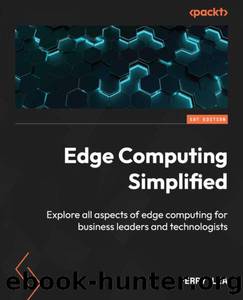Edge Computing Simplified by Perry Lea

Author:Perry Lea
Language: eng
Format: epub
Publisher: Packt Publishing Pvt Ltd
Published: 2024-05-17T00:00:00+00:00
5G and cellular
The concept of wireless telephony had its roots at Bell Labs in 1946, where Douglas Ring and Rae Young created a cellular array of towers that could form a mobile network. In 1979, Motorola came to market with the first cell phone developed by Martin Cooper to brag to a rival that they produced the first mobile phone and phone call. Back then, cellular devices were extremely large, power-hungry, and analog. Modern communication is all digital and needs high speed and low power. What makes cellular systems different than other forms of wireless communication is that the device can be mobile and not at a fixed location. Whereas Wi-Fi may have a reach of a few hundred feet, cellular signals can extend reliable transmission for many miles. This is enabled by the very fact that the radio towers providing communication act as cells and allow a moving mobile phone to hand off from one tower to the next, hence the name cellular.
One of the main governing bodies over the cellular standard is the Third Generation Partnership Project (3GPP). The 3GPP is organized by seven telco organizations worldwide and is responsible for defining the underlying technology to meet the standards set by the International Telecommunications Union (ITU). The ITU defines cellular architectures and roadmaps and governs the standards of mobile communication. This governance body came into existence in 1865, well before wired telephone systems became a mainstay. They are the body that ensures a cellular device that works in North America can also work in Asia-Pacific regions. They also set the standard for the labeling of 3G, 4G, and now, 5G technology.
5G (also called 5G New Radio or 5GNR) is designed to replace the current 4G (Long Term Evolution (LTE) infrastructure. Some parts of 5G are essentially identical to 4GLTE (as they should be) since itâs backward compatible. 5G will fall back to 4G if the user is not within a new cell site. Additionally, a user with a legacy 4G LTE phone may wander into an area with 5G cells, but everything must work and be backward compatible with older mobile devices.
There are three significant benefits for 5G. This is what makes this technology so exciting and important:
Enhanced Mobile Broadband (eMBB): This part of 5G is all about faster, bigger, and better. When most people think of 5G, they think about eMBB as it provides ultra-fast communication. The specification states that 5G can provide 1 Gbps to 10 Gbps in the field. This new radio technology should also support 10x to 100x the number of mobile devices per tower than 4G. 4GLTE can typically serve 100 active users on one cell tower; 5G takes that to over 1,000. Finally, the specification states that this class of service should be operational on vehicles moving at 500 km/hour.
Ultra-Reliable and Low-Latency Communications (URLLC): This portion of the 5G specification states that devices can operate with an end-to-end latency of less than 1 millisecond. Typically, 4G LTE suffers from latency of tens of milliseconds to hundreds of milliseconds.
Download
This site does not store any files on its server. We only index and link to content provided by other sites. Please contact the content providers to delete copyright contents if any and email us, we'll remove relevant links or contents immediately.
Embedded Programming with Modern C++ Cookbook by Igor Viarheichyk(4105)
Implementing Cellular IoT Solutions for Digital Transformation by Dennis McCain(4028)
Linux Device Driver Development Cookbook by Rodolfo Giometti(4024)
Embedded Linux Development Using Yocto Project - Third Edition by Otavio Salvador & Daiane Angolini(3891)
TinyML Cookbook by Gian Marco Iodice(3793)
Simplifying 3D Printing with OpenSCAD by Colin Dow(2906)
TinyML Cookbook by Gian Marco Iodice & Ronan Naughton(2665)
Fusion 360 for Makers by Lydia Sloan Cline(2308)
Networking A Beginner's Guide by Bruce Hallberg(2292)
Hands-On Linux for Architects by Denis Salamanca(2135)
Computers For Seniors For Dummies by Nancy C. Muir(2107)
But How Do It Know? by J. Clark Scott(2081)
Raspberry Pi and MQTT Essentials by Dhairya Parikh(2041)
Arduino Project Handbook, Volume 2: 25 Simple Electronics Projects for Beginners by Geddes Mark(2001)
9781803246888-ENHANCING DEEP LEARNING WITH BAYESIAN INFERENCE by Unknown(1973)
Hack and HHVM by Owen Yamauchi(1959)
31 Days Before Your CompTIA A+ Exams (Shanette Luellen's Library) by Benjamin Patrick Conry(1928)
Hands-On Internet of Things with MQTT by Tim Pulver(1830)
MicroPython Projects by Jacob Beningo(1823)
